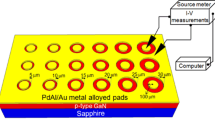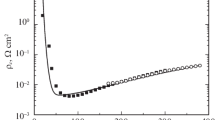Abstract
In this work, the electrical and charge conduction characteristics of a contact structure featuring thermally evaporated MoOx, deposited on n- and p-type crystalline silicon (c-Si), are extensively investigated by room temperature current–voltage (I–V), transmission line measurements (TLM), and temperature-dependent current–voltage measurements (I–V–T). XRD diffraction spectrum shows that the deposited MoOx film exhibits amorphous nature. From TLM measurements, the values of contact resistivity are calculated to be \({\rho_{\rm {c}}}\): 55.9 mΩ-cm2 for Ag/MoOx/n-Si and \({\rho_{\rm {c}}}\): 48.7 mΩ-cm2 for Ag/MoOx/p-Si. The barrier parameters such as barrier height (\({{\phi }_{\mathrm{e}}}\)) and ideality factor (\({n}\)) are investigated by the thermionic emission theory for I–V and I–V–T measurements. The \({{\phi }_{\mathrm{e}}}\), \({n}\), and conventional Richardson plot demonstrate resolute temperature dependency, obeying the barrier height of Gaussian distribution model. The uniform barrier height values are calculated to be \({{\phi }_{\mathrm{b}}}\):1.24 eV for Ag/MoOx/n-Si and \({{\phi }_{\mathrm{b}}}\):0.66 eV for Ag/MoOx/p-Si from the extrapolation of \({{\phi }_{\mathrm{e}}}\) at \({n}\) \({=}\) 1 of the linear fitting of the variation with the experimental barrier height \({{\phi }_{\mathrm{e}}}\) with ideality factor. The activation energy (\({{E}_{\mathrm{a}}}\)) and Richardson constant (A*), obtained from Richardson plot, are much smaller than \({{\phi }_{\mathrm{b}}}\) and the theoretical values of n- and p-type c-Si. The modified Richardson plot yields more reliable Richardson constant and homogeneous barrier height values of 106.2 Acm−2 K−2 and 1.21 eV, 23.4 Acm−2 K−2 and 0.63 eV for Ag/MoOx/n-Si and Ag/MoOx/p-Si heterostructures, respectively. The results demonstrate that thermally evaporated MoOx has particular advantages due to its good rectifying characteristics such as the extra enhancement to barrier height and low contact resistivity for interfacial layer applications.










Similar content being viewed by others
References
A. Thankappan, S. Divya, A.K. Augustine, C.P. Girijavallaban, P. Radhakrishnan, S. Thomas, V.P.N. Nampoori, Thin Solid Films 583, 102 (2015)
J. Chen, J. Lv, Q. Wang, Thin Solid Films 616, 145 (2016)
K. Y. Mitra, C. Sternkiker, C. Martínez-Domingo, E. Sowade, E. Ramon, J. Carrabina, H. L. Gomes, and R. R. Baumann, Flex. Print. Electron. 2, (2017)
S. Mahato, J. Puigdollers, Phys. B 530, 327 (2018)
R. Priya, M.S. Raman, N.S. Kumar, J. Chandrasekaran, R. Balan, Optik (Stuttg). 127, 7913 (2016)
S. Mahato, C. Voz, D. Biswas, S. Bhunia, and J. Puigdollers, Mater. Res. Express 6, (2019)
H. Nasser, G. Kökbudak, H. Mehmood, R. Turan, Energy Procedia 124, 418 (2017)
L.G. Gerling, S. Mahato, A. Morales-Vilches, G. Masmitja, P. Ortega, C. Voz, R. Alcubilla, J. Puigdollers, Sol. Energy Mater. Sol. Cells 145, 109 (2016)
J. Bullock, M. Hettick, J. Geissbühler, A. J. Ong, T. Allen, C. M. Sutter-Fella, T. Chen, H. Ota, E. W. Schaler, S. De Wolf, C. Ballif, A. Cuevas, and A. Javey, Nat. Energy 1, (2016)
J. Bullock, A. Cuevas, T. Allen, and C. Battaglia, Appl. Phys. Lett. 105, (2014)
H. Ali, S. Koul, G. Gregory, J. Bullock, A. Javey, A. Kushima, K.O. Davis, Phys. Status Solidi Appl. Mater. Sci. 216, 1 (2019)
J. Bullock, Y. Wan, Z. Xu, S. Essig, M. Hettick, H. Wang, W. Ji, M. Boccard, A. Cuevas, C. Ballif, A. Javey, ACS Energy Lett. 3, 508 (2018)
O. Almora, L.G. Gerling, C. Voz, R. Alcubilla, J. Puigdollers, G. Garcia-Belmonte, Sol. Energy Mater. Sol. Cells 168, 221 (2017)
G. Masmitjà, L.G. Gerling, P. Ortega, J. Puigdollers, I. Martín, C. Voz, R. Alcubilla, J. Mater. Chem. A 5, 9182 (2017)
L.G. Gerling, C. Voz, R. Alcubilla, J. Puigdollers, J. Mater. Res. 32, 260 (2017)
H. Mehmood, H. Nasser, T. Tauqeer, S. Hussain, E. Ozkol, R. Turan, Int. J. Energy Res. 42, 1563 (2018)
H. Mehmood, H. Nasser, T. Tauqeer, R. Turan, Renew. Energy 143, 359 (2019)
M. Bivour, B. Macco, J. Temmler, W.M.M. Kessels, M. Hermle, Energy Procedia 92, 443 (2016)
M. Bivour, J. Temmler, H. Steinkemper, M. Hermle, Sol. Energy Mater. Sol. Cells 142, 34 (2015)
F. Feldmann, M. Simon, M. Bivour, C. Reichel, M. Hermle, and S. W. Glunz, Appl. Phys. Lett. 104, (2014)
J. Bullock, C. Samundsett, A. Cuevas, D. Yan, Y. Wan, T. Allen, IEEE J. Photovoltaics 5, 1591 (2015)
R.A. Street, Phys. Rev. Lett. 49, 1187 (1982)
M. Bivour, S. Schröer, M. Hermle, Energy Procedia 38, 658 (2013)
Z.C. Holman, A. Descoeudres, L. Barraud, F.Z. Fernandez, J.P. Seif, S. De Wolf, C. Ballif, IEEE J. Photovoltaics 2, 7 (2012)
J. Bullock, A. Cuevas, C. Samundsett, D. Yan, J. McKeon, Y. Wan, Sol. Energy Mater. Sol. Cells 138, 22 (2015)
N. Miyata, T. Suzuki, R. Ohyama, Thin Solid Films 281–282, 218 (1996)
H. Mehmood, H. Nasser, T. Tauqeer, and R. Turan, Proc. 33rd Eur. Photovolt. Sol. Energy Conf. Exhib. 25 - 29 Sept. 2017, Amsterdam, Holl. 932 (2017)
O. Akdemir, M. Zolfaghari Borra, H. Nasser, R. Turan, and A. Bek, Int. J. Energy Res. 44, 3098 (2020)
D. Ahiboz, H. Nasser, and R. Turan, Proc. 2016 Int. Renew. Sustain. Energy Conf. IRSEC 2016 144 (2017)
S.A. Tomas, M.A. Arvizu, O. Zelaya-Angel, P. Rodriguez, Thin Solid Films 518, 1332 (2009)
M. Arita, H. Kaji, T. Fujii, Y. Takahashi, Thin Solid Films 520, 4762 (2012)
R. Singh, R. Sivakumar, S.K. Srivastava, T. Som 507, 144958 (2020)
M. Gülnahar, H. Efeoğlu, Solid-State Electronics 53, 972 (2009)
E.H. Rhoderick, R.H. Williams, Metal-Semiconductor Contacts, 2nd edn. (Clarendon, Oxford, 1988)
D.K. Schroder, Semiconductor Material and Device Characterization, 3rd edn. (Wiley, New York, 2006)
W. Shockley, Research and investigation of inverse epitaxial UHF power transistors (Air Force at. Lab. Wright-Patterson Air Force Base Ohio, 1964)
H.H. Berger, Solid State Electron. 15, 145 (1972)
H.B. Harrison, IEEE Trans. Energy Convers. 4, 160 (1989)
J. P. Kleider, A. S. Gudovskikh, and P. Roca I Cabarrocas, Appl. Phys. Lett. 92, (2008)
H. Abdy, A. Aletayeb, M. Kolahdouz, E.A. Soleimani, AIP Adv. 9, 015216 (2019)
R.T. Tung, Phys. Rev. B 45, 13509 (1992)
J. Osvald, Solid State Electron. 35, 1629 (1992)
Ö. S. Aniltürk and R. Turan, Solid. State. Electron. 44, 41 (2000)
J. H. Werner and H. H. Güttler, J. Appl. Phys. 69, 1522 (1991)
S.M. Sze, Physics of Semiconductor Devices, 2nd edn. (Wiley, New York, 1981), p. 245
M. Gülnahar, Metall. Mater. Trans. A Phys. Metall. Mater. Sci. 46, 3960 (2015)
Funding
Hisham Nasser and Raşit Turan acknowledge the financial support from the Scientific and Technological Research Council of Turkey (TÜBİTAK) [Grant Number 217M087]. Hisham Nasser acknowledges the financial support from TÜBİTAK [Grant Number 217M203].
Author information
Authors and Affiliations
Contributions
MG: Conceptualization, Methodology, Investigation, Wiring—Original draft preparation. HN: Investigation, Supervision, Reviewing and Editing, Project administration. AS: Methodology. RT: Supervision, Resources, Project administration, Funding acquisition.
Corresponding author
Ethics declarations
Conflicts of interest
The authors declare that they have no known competing financial interests or personal relationships that could have appeared to influence the work reported in this paper.
Additional information
Publisher's Note
Springer Nature remains neutral with regard to jurisdictional claims in published maps and institutional affiliations.
Rights and permissions
About this article
Cite this article
Gülnahar, M., Nasser, H., Salimi, A. et al. On the electrical and charge conduction properties of thermally evaporated MoOx on n- and p-type crystalline silicon. J Mater Sci: Mater Electron 32, 1092–1104 (2021). https://doi.org/10.1007/s10854-020-04884-5
Received:
Accepted:
Published:
Issue Date:
DOI: https://doi.org/10.1007/s10854-020-04884-5




